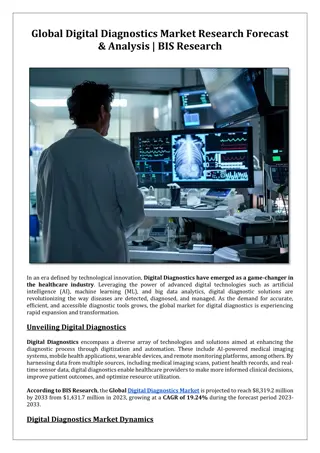
Computed Tomography Market Demand, Outlook and Forecast 2024-2033 | BIS Research
The global computed tomography market is projected to reach $10.21 billion by 2033 from $6.17 billion in 2023, growing at a CAGR of 5.22% during the forecast period 2024-2033.nnRead Report Overview: //bisresearch.com/industry-report/computed-to
Download Presentation

Please find below an Image/Link to download the presentation.
The content on the website is provided AS IS for your information and personal use only. It may not be sold, licensed, or shared on other websites without obtaining consent from the author. If you encounter any issues during the download, it is possible that the publisher has removed the file from their server.
You are allowed to download the files provided on this website for personal or commercial use, subject to the condition that they are used lawfully. All files are the property of their respective owners.
The content on the website is provided AS IS for your information and personal use only. It may not be sold, licensed, or shared on other websites without obtaining consent from the author.
E N D
Presentation Transcript
Computed Tomography Market Size, Volume, Demand, Outlook and Forecast 2024-2033 | BIS Research The computed tomography (CT) market has experienced consistent growth, driven by technological advancements in imaging, the increasing occurrence of chronic diseases, and the growing demand for accurate and early diagnosis. The market remains competitive, with leading companies prioritizing innovations such as high-definition imaging, the incorporation of artificial intelligence (AI), and dose-reduction methods to improve diagnostic precision and patient safety. As the global population ages and healthcare infrastructure expands, the CT market is set to maintain its growth momentum. According to BIS Research, The global computed tomography market is projected to reach $10.21 billion by 2033 from $6.17 billion in 2023, growing at a CAGR of 5.22% during the forecast period 2024-2033. Additionally, the integration of AI and machine learning algorithms into CT systems is expected to transform diagnostic imaging, paving the way for more personalized and efficient healthcare in the future. Hospitals and Ambulatory Surgery Centres Segment to Continue Dominating the Computed Tomography Market The hospitals and ambulatory surgery centers segment of the CT market holds the largest share and is expected to witness continued growth. Factors contributing to this growth include the expansion of
healthcare infrastructure, particularly in emerging markets, to cater to the growing healthcare needs of the population. The diagnostic centers segment of the CT market is expected to experience rapid growth in the coming years. Factors driving this growth include the increasing demand for diagnostic imaging services, the rising prevalence of chronic diseases, and advancements in CT technology. Additionally, the growing trend toward preventive healthcare and early disease detection is expected to boost the utilization of diagnostic imaging services, including CT scans, in diagnostic centers. High-Slice CT Scanners to Lead the Global Computed Tomography Market High-slice CT scanners are expected to see continued growth in demand, driven by the increasing need for high-resolution imaging in various clinical specialties. Factors contributing to their growth include advancements in imaging technology, and the rising prevalence of complex medical conditions requiring detailed anatomical assessment. Mid-slice CT scanners are expected to continue to be a significant segment of the CT market, particularly in community hospitals, outpatient imaging centers, and smaller healthcare facilities. While the growth rate may be moderate compared to high-slice systems, mid-slice CT scanners will remain essential for routine diagnostic imaging and general healthcare services. Request A Detailed Sample on Computed Tomography Market - A Global and Regional Analysis Key Drivers in Computed Tomography Industry 1. Increasing Number of CT Scan Procedures and Rising Demand for CT Scanners: The rising demand for CT scanners is driven by the increasing number of procedures globally, fueled by CT imaging's diagnostic versatility. Widely used in radiology, oncology, cardiology, and emergency medicine, CT scans are essential for diagnosing chronic diseases and trauma. Technological advancements like multi-slice scanners, dose reduction, and AI integration have enhanced their capabilities. 2. Growing Emphasis on Effective and Early Disease Diagnosis: Computed tomography (CT) plays a vital role in meeting the increasing demand for early and effective disease diagnosis. With high-resolution imaging, CT scans help detect conditions at early stages, especially in cancer screening. Their speed and accuracy support swift diagnoses, enabling timely medical interventions and proactive healthcare management. 3. Increasing Focus on Mobile CT Scanners: The demand for mobile CT scanners is rapidly increasing due to their flexibility and practicality in healthcare. Ideal for emergency scenarios like natural disasters, they enable quick, on-site diagnostics. Mobile units also improve access to advanced imaging in rural areas, ensure operational continuity during facility disruptions, and enhance patient throughput. Technological advancements and cost-effectiveness further drive their growing importance in modern healthcare. Competitive Landscape The computed tomography (CT) market is highly competitive, shaped by technological innovations, pricing strategies, regulatory frameworks, and market consolidation. It is a relatively mature market,
with a few major companies leading the sector. Key players include prominent diagnostic imaging firms like Siemens Healthineers, GE Healthcare, Koninklijke Philips N.V., Canon Medical Systems Corporation, and Fujifilm Holdings Corporation, among others, which dominate the industry. Get Insights on Robotics and Imaging Market Research Report According to Research Analyst - BIS Research The global computed tomography (CT) market is projected to witness significant growth due to several factors. Technological advancements, such as high-resolution scanners and dual-energy CT, are improving diagnostic accuracy and expanding medical applications. The rising prevalence of chronic diseases like cancer and cardiovascular disorders is increasing demand for CT scans. Additionally, the aging population, higher healthcare spending, and improved access to CT technology contribute to this growth. Expanding CT uses beyond diagnostics into interventional procedures and research further boosts market appeal, indicating strong future growth for the CT market.






















